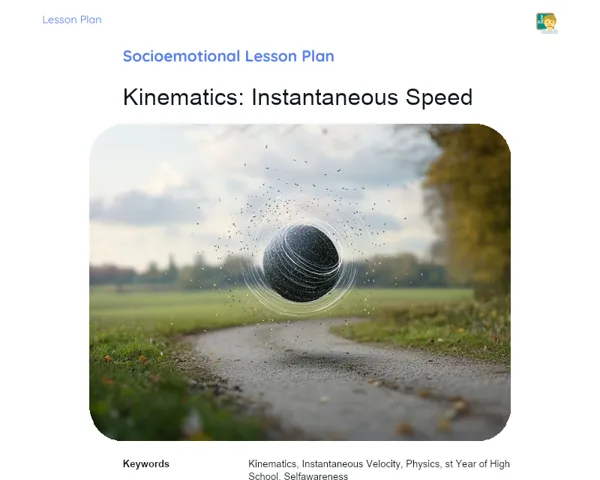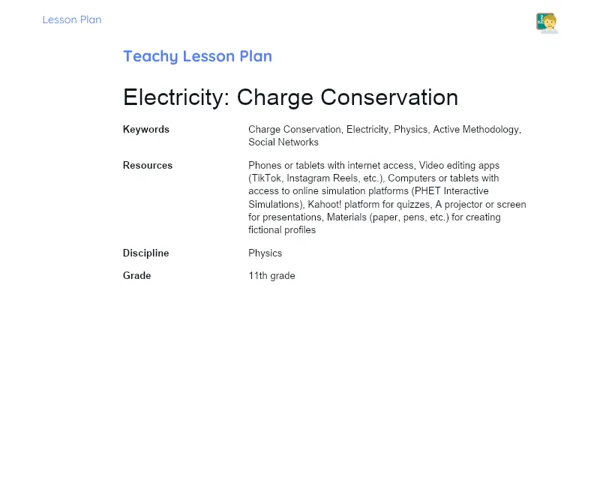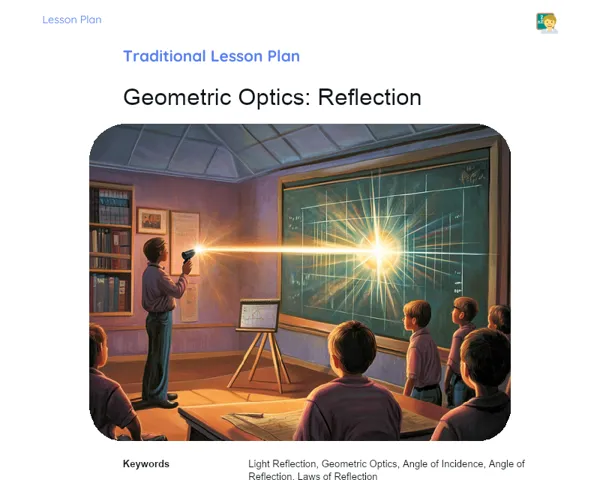Lesson Plan | Lesson Plan Iteratif Teachy | Momentum and Impulse: Conservation of Momentum
| Keywords | Impulse, Momentum, Conservation, Collisions, Digital Methodology, Physics, High School, Gamification, Social Media, Online Simulations, Active Learning, Problem Solving, Digital Tools, CSI Investigations, 360° Feedback |
| Resources | Phones with internet access, Computers or Tablets, Scratch platform or similar, Instagram account (can be temporary), Online collision simulators (e.g. PhET Collision Lab), Materials for simple home experiments (optional), Access to tutorials and online resources |
| Codes | - |
| Grade | 10th grade |
| Discipline | Physics |
Goal
Duration: 10 - 15 minutes
This section aims to clearly outline the lesson objectives, guiding students on the skills they should be able to demonstrate by the end of the lesson. This helps focus their attention and motivation towards the practical activities and discussions planned, ensuring a deeper grasp of the topic.
Goal Utama:
1. Understand and apply the concept of conservation of momentum in various contexts.
2. Solve problems involving collisions and determine the velocities after impacts using momentum.
Goal Sekunder:
- Encourage critical thinking and problem-solving through engaging and interactive activities.
Introduction
Duration: 10 - 15 minutes
🔎 Purpose: The goal of this phase is to capture students' interest from the outset, linking the lesson topic to real-world examples relevant to them. By promoting active exploration of interesting facts and fostering initial discussions, students are encouraged to engage critically and practically in their learning, setting a context that allows for a deep understanding of conservation of momentum.
Warming Up
🟢 Warm-up: Introduce the lesson on 'Impulse and Momentum: Conservation of Momentum', explaining in clear terms that this concept is crucial for understanding object interactions during collisions and how momentum is conserved in closed systems. Invite students to use their phones to find an interesting fact about momentum or a practical example of this concept. Encourage sharing their findings with the class, sparking initial discussions and linking the topic to their everyday experiences.
Initial Thoughts
1. 🔍 Key Questions:
2. What occurs to the momentum of an object following a collision in a closed system?
3. How can we leverage momentum to anticipate the velocities of objects post-collision?
4. Can you think of practical, everyday instances of conservation of momentum?
5. In which scenarios is the momentum of a system not conserved? What’s the reason?
Development
Duration: 70 - 75 minutes
This stage aims to provide a practical and contextualized application of conservation of momentum, utilizing modern technologies and methodologies to actively engage and motivate students. These activities allow for hands-on experimentation and a profound understanding of the content through interactive and playful approaches.
Activity Suggestions
Activity Recommendations
Activity 1 - 🎮 Digital Collisions - Gamification Challenge
> Duration: 60 - 70 minutes
- Goal: Apply the conservation of momentum concept in a fun, practical context that reinforces understanding through game development.
- Deskripsi Activity: In this activity, students will create a simple game using an online platform like Scratch to simulate object collisions. They must program various collision scenarios and observe how momentum is conserved.
- Instructions:
-
Split the class into groups of up to 5 students.
-
Guide them to access the Scratch platform (or another suitable game development site).
-
Explain that they need to design a game featuring two colliding objects. They should program the actions of the objects before and after the collision, ensuring momentum conservation is checked.
-
Encourage them to implement various difficulty levels by altering the mass and speed of the objects.
-
Each group should present their game to the class, explaining how they incorporated the conservation of momentum concept.
-
Groups may utilize tutorials and online resources to assist in game creation.
Activity 2 - 📱 Digital Influencers - Exploring Collisions on Instagram
> Duration: 60 - 70 minutes
- Goal: Utilize social media to express scientific ideas, making learning more dynamic and connected to students' realities.
- Deskripsi Activity: Students will craft a series of Instagram stories that illustrate the concept of conservation of momentum using everyday examples and simple home experiments. They should utilize images, videos, and text to convey their ideas creatively and effectively.
- Instructions:
-
Arrange the class into groups of up to 5 students.
-
Direct students to use their phones to connect to Instagram.
-
Each group should create a temporary account (if they prefer not to use their personal accounts) for the task.
-
Explain they need to produce a series of stories that clarify conservation of momentum. The stories should feature:
-
Practical examples of everyday collisions (like sports, car accidents, etc.).
-
Videos from simple home experiments demonstrating the concept.
-
Concise and appealing theoretical explanations.
-
Practical tips on momentum calculations in various scenarios.
-
Each group should showcase their series of stories to the class, detailing the rationale behind each example and experiment.
Activity 3 - 🔍 CSI: Collision Investigation
> Duration: 60 - 70 minutes
- Goal: Cultivate investigative and analytical skills by applying conservation of momentum principles in realistic scenarios.
- Deskripsi Activity: In this activity, students will take on the role of investigators examining a vehicle collision. Using online simulations and supplied data, they will calculate the speeds of the vehicles prior to and post-collision, applying the conservation of momentum principle.
- Instructions:
-
Organise the class into groups of up to 5 students.
-
Provide each group with a fictional collision scenario, including specifics like vehicle masses and conditions before and after the incident.
-
Instruct students to use online collision simulators (like the PhET Collision Lab) to recreate the scenario.
-
Students must compute the momentum of the vehicles before and after the crash and determine if momentum was conserved.
-
Groups should prepare a comprehensive report detailing their findings and present it to the class.
-
Encourage the use of graphs and tables to illustrate their results.
Feedback
Duration: 25 - 30 minutes
📝 Purpose: The purpose of this stage is to consolidate learning through reflection and sharing experiences. Group discussions allow students to revisit and reinforce the content covered, while the 360° feedback promotes the development of interpersonal skills and fosters a culture of support and mutual growth.
Group Discussion
🔵 Group Discussion: Lead a group discussion with all students where they share insights gained from the activities and their conclusions. Follow this brief outline to facilitate the discussion:
Start by thanking everyone for their engagement in the activities. Ask each group to present a summary of their contributions, describing the challenges they faced and the solutions they developed. Encourage reflection on how the conservation of momentum played a role in their specific activities. Promote idea-sharing between groups, fostering collaboration and collective learning.
Reflections
1. 🤔 Reflection Questions: 2. What were the major challenges encountered when applying conservation of momentum in your activity? 3. How did digital tools enhance understanding of conservation of momentum? 4. Post-activities, how would you apply the conservation of momentum in everyday situations that weren’t covered in class?
Feedback 360º
🎤 360° Feedback: Guide students in executing a 360° feedback session, where each member must receive constructive feedback from their group peers. Ensure the feedback is respectful and supportive, adhering to these guidelines:
Positive Feedback: Acknowledge something the member did well during the activity. Areas for Improvement: Identify a specific area for improvement, offering practical suggestions. Closing: Wrap up with words of encouragement, highlighting the importance of teamwork and continuous learning.
Conclusion
Duration: 10 - 15 minutes
🎓 Purpose: This stage aims to cement learning by reflecting on how the theory covered applies across different practical contexts. It reinforces the relevance of the topic and illustrates the positive impact of this knowledge on students' lives, encouraging them to delve deeper into the captivating world of physics.
Summary
🎢 Fun Summary: To wrap up our exploration of Impulse and Momentum, let’s take a swift ride on the 'Knowledge Roller Coaster'! First, we learned that momentum is invariably conserved in isolated systems, akin to a physics magic act! Next, we applied this understanding to collision scenarios, whether in reality or in the digital realm, discovering how to predict the speeds of objects post-impact. Finally, we created games, Instagram stories, and even acted like real CSIs in our investigations! 🚀
World
🌍 In Today’s World: Understanding conservation of momentum is like having a master key to unravel many mysteries of the world around us. From vehicles to sports to tiny subatomic particles, collisions are everywhere! The capability to predict and calculate these events is vital in fields such as engineering, sports science, and even video game development, showcasing how physics is vibrant in our digital and dynamic daily lives.
Applications
📱 Everyday Applications: Mastering the concept of conservation of momentum aids in comprehending everything from safety in car collisions to executing dazzling tricks on a skateboard. Knowing how to predict and calculate impact outcomes proves invaluable in daily life as well as potential future careers in STEM (Science, Technology, Engineering, and Mathematics).



